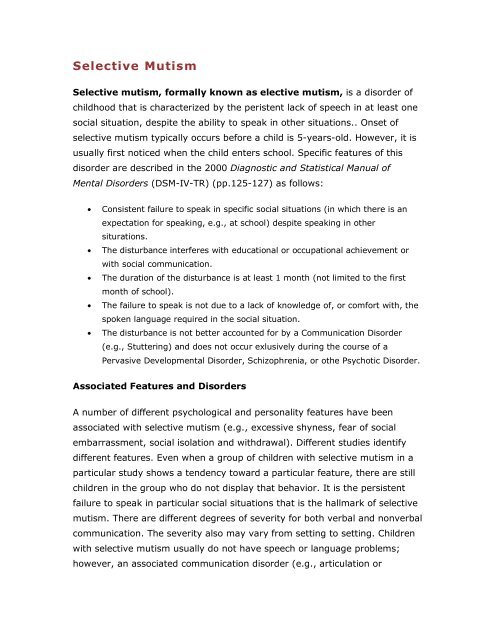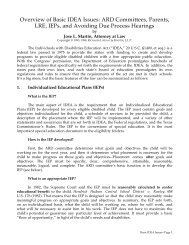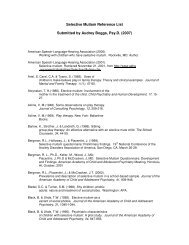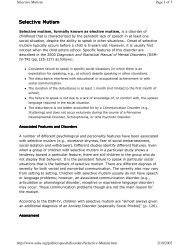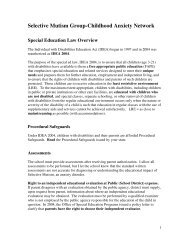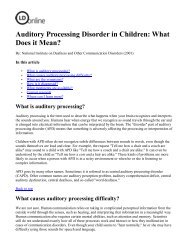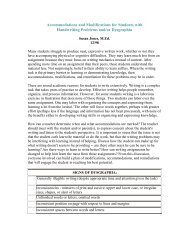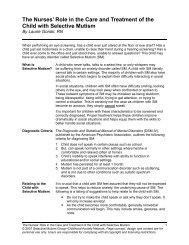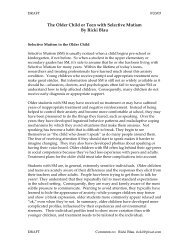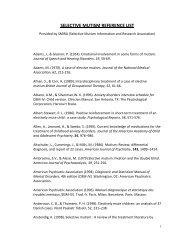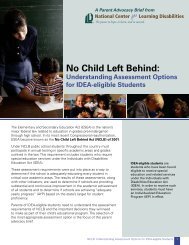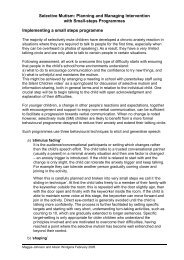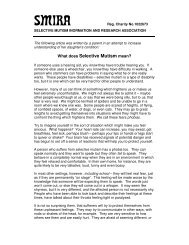Selective Mutism
SM Definition - Selective Mutism Group
SM Definition - Selective Mutism Group
- No tags were found...
You also want an ePaper? Increase the reach of your titles
YUMPU automatically turns print PDFs into web optimized ePapers that Google loves.
<strong>Selective</strong> <strong>Mutism</strong><strong>Selective</strong> mutism, formally known as elective mutism, is a disorder ofchildhood that is characterized by the peristent lack of speech in at least onesocial situation, despite the ability to speak in other situations.. Onset ofselective mutism typically occurs before a child is 5-years-old. However, it isusually first noticed when the child enters school. Specific features of thisdisorder are described in the 2000 Diagnostic and Statistical Manual ofMental Disorders (DSM-IV-TR) (pp.125-127) as follows:• Consistent failure to speak in specific social situations (in which there is anexpectation for speaking, e.g., at school) despite speaking in othersiturations.• The disturbance interferes with educational or occupational achievement orwith social communication.• The duration of the disturbance is at least 1 month (not limited to the firstmonth of school).• The failure to speak is not due to a lack of knowledge of, or comfort with, thespoken language required in the social situation.• The disturbance is not better accounted for by a Communication Disorder(e.g., Stuttering) and does not occur exlusively during the course of aPervasive Developmental Disorder, Schizophrenia, or othe Psychotic Disorder.Associated Features and DisordersA number of different psychological and personality features have beenassociated with selective mutism (e.g., excessive shyness, fear of socialembarrassment, social isolation and withdrawal). Different studies identifydifferent features. Even when a group of children with selective mutism in aparticular study shows a tendency toward a particular feature, there are stillchildren in the group who do not display that behavior. It is the persistentfailure to speak in particular social situations that is the hallmark of selectivemutism. There are different degrees of severity for both verbal and nonverbalcommunication. The severity also may vary from setting to setting. Childrenwith selective mutism usually do not have speech or language problems;however, an associated communication disorder (e.g., articulation or
phonological disorder, receptive or expressive language disorder) may occur.These communication problems though are not the main reason for themutism.According to the DSM-IV, children with selective mutism are “almost alwaysgiven an additional diagnosis of an Anxiety Disorder (especially SocialPhobia)” (p. 126).AssessmentThe speech-language pathologist works as part of a collaborative,interdisciplinary team consisting of the pediatrician, a psychologist orpsychiatrist, the teacher(s), and the family. The speech-language pathologistwill conduct a thorough parental interview , as most children who areselectively mute will not talk to the clinician. Use Find a Professional to locatea speech-language pathologist near you.This interview seeks information on:• the child's symptom history, especially focusing on the onset of thebehaviors. The majority of children with selective mutism do not have asudden onset of symptoms• the degree to which the child is verbally and non-verbally inhibited,which may vary from setting to setting . Parents may be asked to provideinformation about the child's relationships with friends or to describe how thechild communicates in social situations outside of school (e.g., interactingwith other children and adults on the playground or talking on the telephone).• associated problems (e.g., schizophrenia, pervasive developmentaldisorder) that could be contributing to the failure to speak. It is possible torule out selective mutism if one of these are present.• the child's speech and language development, as well as current use andcomprehension of language. Does the child understand what people say tohim or her? Does the child understand questions and follow directions? Is thechild able to find the words needed to express ideas? The parent may beasked to describe the child's speech production (i.e., pronunciation of words,quality/tone/pitch of voice, fluency of speech) to help rule out any otherspeech and language disabilities that could be causing or exacerbating the
mutism. Current studies show that 20-30 percent of children with selectivemutism have other speech and language disabilities; however, these are notthe cause of the mutism. It is important to address these speech andlangaugedifficulties so the child can become more comfortable withcommunication.• any environmental influences (i.e., learning more than one language at atime or not having adequate language stimulation) that may affect the child'scomfort and confidence with the language.• family history of psychiatric (e.g., social phobia, obsessive-compulsivedisorder, or other anxiety disorders) and personality (e.g., extreme shyness)diagnoses that may be predisposing the child to mutism. The clinician reviewsthe child's medical history to rule out physical problems (e.g., neurologicaldelay) underlying the mutism.The speech-language pathologist will also review educational history viaacademic reports, parent/teacher comments, and standardized testing. Dothese reports indicate concern about the child's communication skills withpeers or adults in the classroom? Are teachers concerned about the child'sacademic achievement? The clinician reviews the reports of any previoustesting (e.g., psychological) to assess whether other diagnosed disabilitiescould be causing or exacerbating the mutism.The speech-language pathologist will then conduct a speech and languageevaluation . The child’s anxiety level should be taken into account.Accommodations should be considered in order to evaluate the child incomfortable surroundings and with familiar people. A parent might bepresent to help facilitate communication. If any evaluation procedures aretoo anxiety provoking they should be discontinued.• The clinician interviews the child to observe the quality of verbal and nonverbalcommunication . This is done through informal play activities (e.g.,playing together with a dollhouse and using the dolls and accessories tostimulate dialogue and social interaction). If the child is having difficultyparticipating in these play activities, the clinician should try another type ofactivitiy. Drawing may be used as a means to explore non-verbalcommunication skills.
• Comprehension of language is evaluated using standardized tests (e.g.,the child is shown a set of four pictures and is told to point to one of thepictures) and informal observation.• The parent may be asked to do structured communication activitieswith the child (e.g., have the child retell the plot of a story or describe apicture) to create an informative videotape. The parent may also be asked toprovide a videotape of the child's speech at home during regularconversation. These samples enable the speech-language pathologist toevaluate expressive language abilities (word knowledge, use of grammar,ability to sequence a set of ideas, social communication skills). The speechlanguagepathologist may attempt to conduct an oral-motor examinationto evaluate the strength and coordination of the muscles in the child's lips,jaw, and tongue. Muscle weakness or incoordination may signify aneurological impairment that is may lead to a diagnosis other than selectivemutism.• S creening test for hearing and middle ear function should also be partof the evaluation.TreatmentThe speech-language pathologist may coordinate a behavioral treatmentprogram to increase verbalizations. Behavioral treatment is based on thepremise that the child who is selectively mute is using the behavior inresponse to anxiety in social situations. The focus of the speech-languagepathologist’s intervention is to reinforce communication with a gradualprogression from non-verbal to verbal. This may be accomplished throughstimulus fading, in which the speech-language pathologist sets simple goals(e.g., using a gesture to communicate) and gradually increases expectationsuntil speech is achieved. Another behavioral treatment technique calledshaping reinforces mouth movements that approximate speech (e.g.,whispering) until true speech is achieved. Another technique sometimesused, when the child is willing, isthe self-modeling technique where the childwatches videotapes of himself or herself performing the desired behavior(e.g., communicating effectively at home) to facilitate self-confidence andcarry-over of this behavior into the classroom. The speech-language
pathologist should collaborate with the psychologist, whose primary focus willbe to help reduce the child’s anxiety.The speech-language pathologist may also work with specific speech andlanguage problems that are making the mute behavior worse. Forexample, some children with selective mutism are afraid to speak becausethey feel they may say the wrong thing. The speech-language pathologistmay use role-playing activities to lessen the child's anxiety and increaseconfidence with speaking to different listeners in a variety of settings. Otherchildren with selective mutism may not want to speak because they feel theirvoice "sounds funny." If necessary, the speech-language pathologist maywork on speech pronunciation to increase the child's confidence and clarity ofspeech.Additionally, the speech-language pathologist likely will work in the child'sclassroom with teachers to encourage communication and lessen anxietyabout speaking. For example, the speech-language pathologist may help theteacher implement the use of small, cooperative groups within the classroomthat are less intimidating for the child with selective mutism. Then, thespeech-language pathologist will work with the child within this group tofacilitate more effective communication with peers, first using non-verbalcommunication methods, such as signals or cards, to contribute to smallgroup discussions and gradually adding goals to include speech. The speechlanguagepathologist will work with the child, family, and teachers togeneralize learned communication behaviors into other speaking situations.The speech-language pathologist continues to work as part of the schoolbasedinterdisciplinary team to treat the child with selective mutism.The type of intervention will differ depending on the needs of the child andhis or her family. The child's treatment may use a combination of strategies,again depending on individual needs.How Common Is It?
According to the DSM-IV, selective mutism is an apparently rare disorderthat affects fewer than 1% of individuals seen in mental health settings. (p.126).ASHA Technical Information PacketWorking With Children who Have <strong>Selective</strong> <strong>Mutism</strong>Item #0112293Order by calling ASHA product sales 1-888-498-6699 or by visiting our onlinestore.Text Size:| | |Print Friendly |Send to a FriendRelated Resources:• Speech and Language Disorders• A Letter on Aphasia from a Concerned Son• AAC: More Than Three Decades of Growth and Development• Amyotrophic Lateral Sclerosis• Amyotrophic Lateral Sclerosis: A Challenge for Speech-Language Pathology• Aphasia• Apraxia in Adults• Attention Deficit Hyperactivity Disorder• Augmentative and Alternative Communication Decisions• Augmentative Communication: A Glossary• Childhood Apraxia of Speech• Dementia• Dysarthria• Facts About Oral Cancer• Family Adjustment to Aphasia• Feeding and Swallowing Disorders in Infants and Children• Growing Up with AAC• Head and Neck Cancer• Huntington's Disease• Introduction to Augmentative and Alternative Communication• Language-Based Learning Disabilities• Laryngeal Cancer• Late Blooming or Language Problem?• Long-Term Recovery After Stroke• Louis, the Trumpeter Swan
• Orofacial Myofunctional Disorders• Paradoxical Vocal Fold Movement• Right Hemisphere Brain Damage• <strong>Selective</strong> <strong>Mutism</strong>• Spasmodic Dysphonia• Speech for Patients With Tracheostomies or Ventilators• Stroke• Stuttering• Swallowing Problems After Head and Neck Cancer• Traumatic Brain Injury• Vocal Fold Nodules and Polyps• Vocal Fold Paralysis• Voice Lessons - speaking with ALSOther Sections• Development• Disorders & Diseases• Swallowing• Find a Speech-Language Pathologist• Get Speech, Language & Swallowing Information by Request• ASHA & NSSLHA MembersoooooooooooooAudiology & AudiologistsSpeech-Language Pathology & SLPsFaculty, Researchers & PhDsASHA Desk ReferenceASHA Full-Text JournalsBilling & ReimbursementConnect to ColleaguesDiscussion ForumsMembership DirectoryData & ResearchEvidence-Based PracticeMember Services / National OfficePromote Your Services & Profession• Members & ProfessionalsoASHA Convention
ooASHA Leader OnlineASHA Membership, Certification,Special Interest Divisions & AffiliatesooooASHA PublicationsASHA State-by-StateCareer CenterContinuing Education &ASHA Professional DevelopmentooooooooConferences & EventsCredentialingEthics: Documentation & IssuesLeadership, Awards & InitiativesLegislation & AdvocacyMarketing with ASHAMulticultural Issues & ResourcesPress Room• StudentsoLearn About the ProfessionsoooooooFind an Academic ProgramGuide to Graduate ProgramsStudent Association (NSSLHA)Get Financial AidLearn About the Praxis ExamEarn Certification & Join ASHAStart a Career: Job Search Tips• The PublicoHearing & BalanceooooSpeech, Language & SwallowingAbout Health InsuranceAdding Speech & Hearing BenefitsAdvocacy & Outreach
ooASHA Certification & RecognitionFind a Professional©1997-2006 American Speech-Language-Hearing Association - Copyright Notice and LegalDisclaimerContacts | Jobs | News RoomSite Help | Site Map


